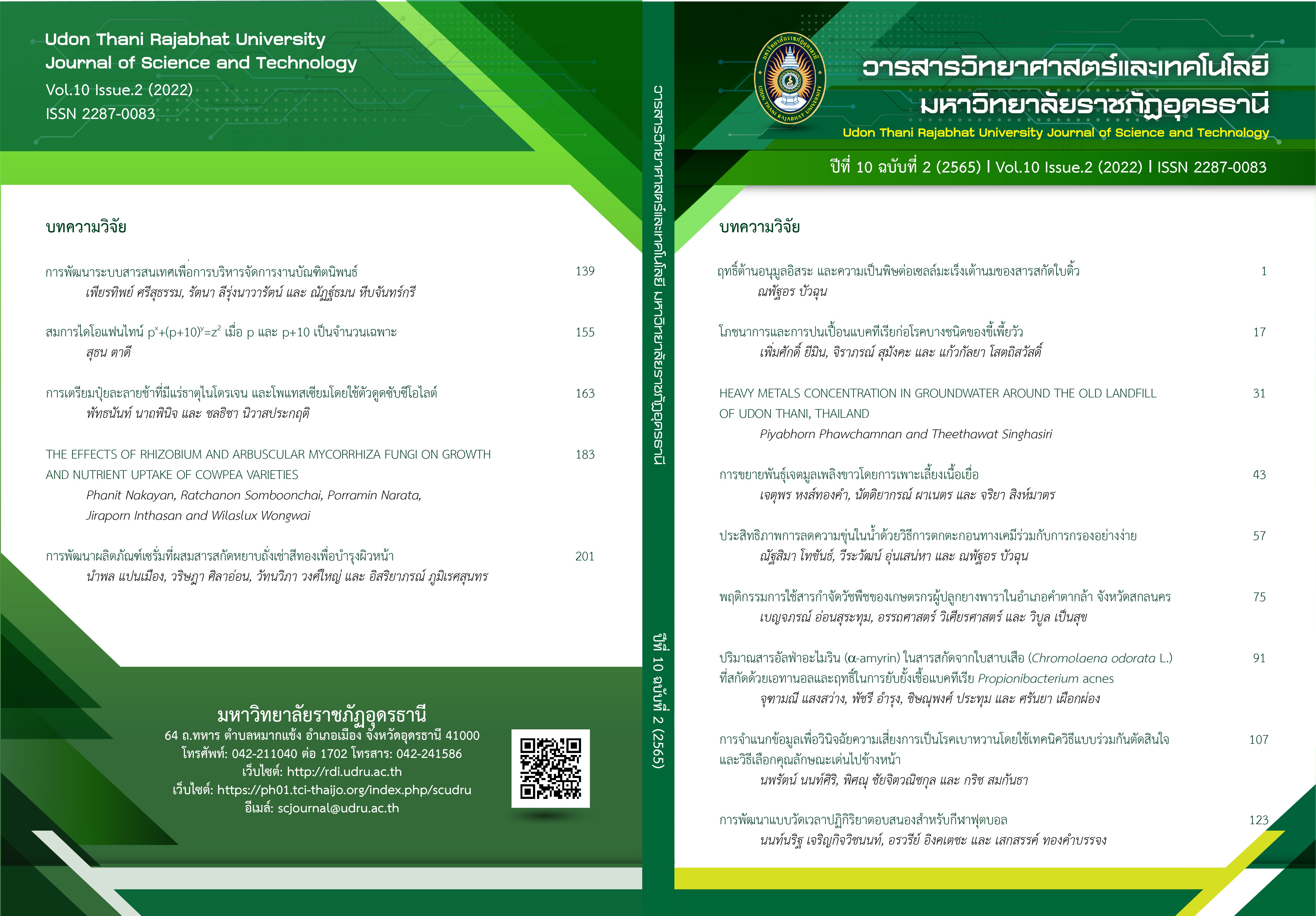ANTIOXIDANT AND CYTOTOXIC ACTIVITIES OF CRATOXYLUM FORMOSUM CRUDE AGAINST BREAST CANCER CELLS (MCF-7)
Main Article Content
Abstract
The purposes of this research were to investigate the content of phenolic compounds, flavonoid compounds, antioxidant activity and cytotoxic of hexane, ethyl acetate, and methanol extracts from Cratoxylum formosum leaves against MCF-7 human breast cancer cells. The experimental results indicated that methanol C.formosum extract had the highest content of phenolic compounds, flavonoid compounds and antioxidant activity of 150.21 mg GAE/g, 41.81 mg QE/g, and 9.87 mg/mL, respectively. Methanol C. formosum extract had the highest inhibitory activity against the growth of MCF-7 human breast cancer cells with IC50 of 12.45 ± 2.69 µg/mL.
Article Details
References
คณะเภสัชศาสตร์ มหาวิทยาลัยศิลปากร. (2563). ข้อมูลพืชสมุนไพรคณะเภสัชศาสตร์ มหาวิทยาลัยศิลปากร. สืบค้นเมื่อ 12 กันยายน 2563, จาก https://pharmacy.su.ac.th/herbmed/herb/text/herb_detail.php?herbID=268.
ณพัฐอร บัวฉุน. (2563). สารพฤกษเคมีเบื้องต้น และฤทธิ์ต้ํานอนุมูลอิสระของสลัดน้ำพืชสดและพืชแห้ง. วารสารวิชาการมหาวิทยาลัยอีสเทิร์นเอเชีย ฉบับวิทยาศาสตร์และเทคโนโลยี, 14(1), 144-154.
ธีรวุฒิ คูหะเปรมะ. (2560). โรคมะเร็ง. สืบค้นเมื่อ 5 กันยายน 2563, จาก https://www. wattanosothcancerhospital.com/all-about-cancer/general-information-about-cancer.
ธนศักดิ์ แซ่เลี่ยว, ศศิธร จันทนวรางกูร และ วรรณี จิรภาคย์กุล. (2551). ผลของตัวทำละลายต่อปริมาณสารประกอบฟีนอลิกและความสามารถต้านออกซิเดชันของกระชายเหลือง (Boesenbergia pandurata). ใน: การประชุมทางวิชาการของมหาวิทยาลัย เกษตรศาสตร์ ครั้งที่ 46, วันที่ 29 มกราคม – 1 กุมภาพันธ์. มหาวิทยาลัย เกษตรศาสตร์, กรุงเทพฯ. 538-545.
นันทวัน บุณยะประภัศร. (2536). การตรวจสอบทางเคมีเบื้องต้นของสารสกัดจากพืช. ใน วันดี กฤษณพันธ์ (ผู้รวบรวม), ยาและผลิตภัณฑ์ธรรมชาติ เล่มที่ 1 (หน้า 116-129). ภาควิชาเภสัชวินิจฉัย, คณะเภสัชศาสตร์มหาวิทยาลัยมหิดล.
บังอร วงศ์รักษ์ และ ศศิลักษณ์ ปิยะสุวรรณ์. (2549). ฤทธิ์ต้านอนุมูลอิสระของผักพื้นบ้าน. (วิทยานิพนธ์เภสัชศาสตรบัณฑิต, มหาวิทยาลัยมหิดล).
ภาเกล้า ภูมิใหญ่ และ ชญาณิศา สุพา. (2558). ตัวทำละลายที่มีผลต่อฤทธิ์ต้านอนุมูลอิสระและสารประกอบฟีนอลิกทั้งหมดจากพืชสมุนไพร. ใน: การประชุมวิชาการระดับชาติ สถาบันวิจัยและพัฒนา มหาวิทยาลัยราชภัฏกำแพงเพชร ครั้งที่ 2, วันที่ 22 ธันวาคม 2558. มหาวิทยาลัยราชภัฏกำแพงเพชร, กำแพงเพชร, 627-635.
วันเพ็ญ เจริญจิต. (2547). พรอพอลิสจากผึ้งผลิตภัณฑ์ธรรมชาติต้านโรค. ชมรมการจัดการทรัพยากรเกษตร. สืบค้นเมื่อ 12 กันยายน 2563, จาก https://www.Matichon. co.th.
วสันต์ สุมินทิลี่, ปนิดา บรรจงสินศิริ, จันทนา ไพรบูรณ์ และ วรรณวิมล คล้ายประดิษฐ. (2557). กิจกรรมการต้านอนุมูลอิสระของสารสกัดหยาบจากสาหร่ายพวงองุ่น (Caulerpa lintillifera) สาหร่ายทุ่น. วารสารเทคโนโลยีการอาหาร มหาวิทยาลัยสยาม, 9(1), 63-75.
ศรมน สุทิน, กิตติพัฒน์ โสภิตธรรมคุณ และ พัชรี ภคกษมา. (2560). การทดสอบความ สามารถในการต้านอนุมูลอิสระและการยับยั้งการเจริญของเซลล์มะเร็งท่อน้ำดีของสารสกัดจากใบต้นจำปีและจำปา. กรุงเทพฯ: มหาวิทยาลัยหัวเฉียวเฉลิมพระเกียรติ.
ศูนย์ข้อมูลออนไลน์. (2563). 5 อันดับ มะเร็งในคนไทย รู้ไว้ใกล้ตัวกว่าที่คิด!. สืบค้นเมื่อ 20 ตุลาคม 2563, จาก http://www.ashthailand.or.th/smartnews/post/detail/558/news_all.php.
อรพรรณ จันทรวิชิต และ ชัชฎาพร องอาจ. (2558). ปริมาณสารประกอบฟีนอลิกรวมฤทธ์การต้านอนุมูลอิสระ และการต้านเชื้อจุลินทรีย์ของสารสกัดวัชพืช. วารสารวิทยาศาสตร์เกษตร, 46(ฉบับพิเศษ 3), 285-288.
อนันต์ อธิพรชัย, สุรีย์พร หอมวิเศษวงศา และ สุวรรณา เสมศรี. (2562). การค้นหาและพัฒนาสมุนไพรไทยสำหรับรักษาโรคเบาหวาน. ชลบุรี: มหาวิทยาลัยบูรพา.
Arvouet-Grand, A., Vennat, B., Pourrat, A., & Legret, P. (1994). Standardization of propolis extract and identification of principal constituents. Journal de Pharmacie de Belgique, 49(6), 462-468.
Bagchi, K., & Puri, S. (1998). Free radicals and antioxidants in health and disease: a review. Eastern Mediterranean Health Journal, 4(2), 350-360.
Benjaporn, B., Nootchanat, M., & Ampa, K. (2017). Cratoxy formosum leaf extract inhibits proliferation and migration of human breast cancer MCF-7 cells. Biomedicine and pharmacotherapy, 90, 77-84.
Beyer, R. (1992). An Analysis of Role of Coenzyme Q in Free Radical Generation and As Antioxidant. Biochemistry and Cell Biology, 7, 390–403.
Braca, A., Sortion, C., Politi, M., Morelli, I., & Meddez, J. (2002). Antioxidant activity of flavonoids from Liccania licaniaeflora. Journal of Ethnopharmacology, 79(3), 379–381.
Bundit, P., Jureerut, D., Ponlatham, C., Ratree, T., Tueanjit, K., Narintorn, R., Roongpet, T., & Patcharee, B. (2015). Cytotoxicity of Cratoxylum Formosum Subsp.
Pruniflorum Gogel Extracts in Oral Cancer Cell Lines. Asian Pacific Journal of Cancer Prevention, 16(16), 7155-7159.
Dugas, A. J., Castaneda-Acosta, J., Bonin, G. C., Price, K. L., Fischer, N. H., & Winston, G. W. (2000). Evaluation of the total peroxyl radical-scavenging capacity of flavonoids: structure-activity relationships. Journal of Natural Products, 63(3), 327-331.
Lou, Y., Joseph, S., Li, L., Graber, E., Liu, X., & Pan, G. (2016). Water Extract from Straw Biochar Used for Plant Growth Promotion: An Initial Test. BioResources, 11(1), 249-266.
Majhenic, L., Skerget, M., & Knez, Z. (2007). Antioxidant and antimicrobial activity of quarana seed extracts. Food Chemistry, 104(3), 1258-1268.
Pereira D., Valentão, P., Pereira, J., & Andrade, P. (2009). Phenolic: From chemistry to biology. Molecules, 14, 2202-2211.
Pietta, P. (2000). Flavonoids as antioxidants. Journal of Natural Products, 63, 1035-1042.
Pourmorad, F., Hosseinimehr, S., & Shahabimajd, N. (2006). Antioxidant activity, phenol and flavonoid contents of some selected Iranian medicinal plants. African Journal of Biotechnology, 5(1), 1142-1145.
Ren Y., Matthew S., Lantvit D. D., Ninh T. N., Chai H., Fuchs J. R., Soejarto D. D., Carcache E. J., Swanson S. M., & Kinghorn A. D. (2011). Cytotoxic and NF-kB Inhibitory constituents of the stems of Cratoxylum cochinchinense and their semisynthetic analogues, Journal of Natural Products, 74, 1117-1125.
Rice-Evans, C. A. & Miller, N. J. (1996). Antioxidant activities of flavonoids as bioactives compounds of foods. Biochemical Society Transactions, 24(3), 790-795.
Su C. C., Lin J. G., Li T. M., Chung J. G., Yang J. S., Ip S. W., Lin W. C., & Chen G. W. (2006). Curcumin-induced apoptosis of human colon cancer colo 205 cells through the production of ROS, Ca2+ and the activation of caspase-3. Anticancer Research, 26, 4379–4389.
Woraratphoka, J., Intarapichet, K., & Indrapichate, K. (2012). Antioxidant activity and cytotoxicity of six selected, regional, Thai vegetables. American-Eurasian Journal of Toxicological Sciences, 4, 108-117.


